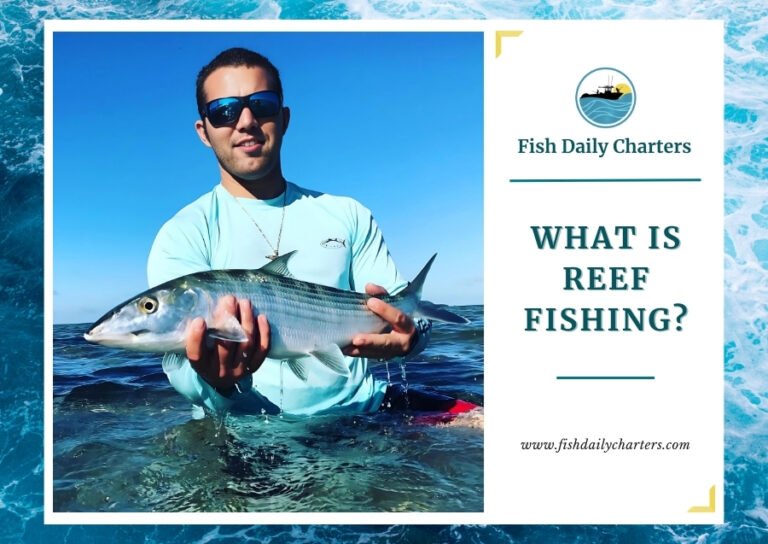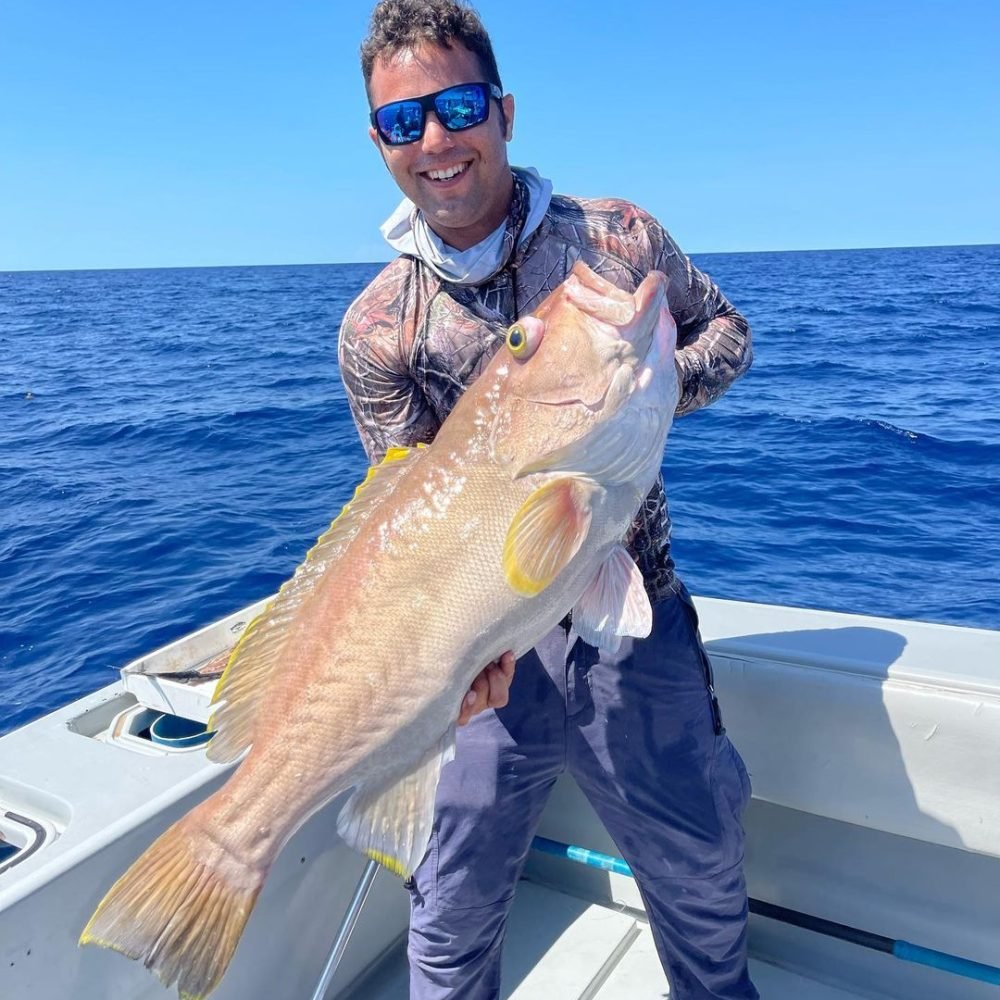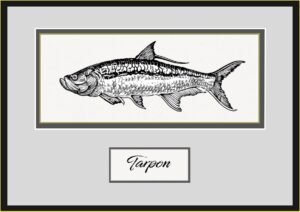Fishing near coral reefs, also known as reef fishing, takes place in shallower waters, typically less than 30 meters deep and closer to the coast. This type of fishing is popular for its unique challenges and the vibrant marine life found in reef environments.
Reef fishing involves catching a variety of fish using specialized equipment. Anglers commonly use techniques like bottom, drift, and live bait fishing. People love to catch snapper, grouper, barracuda and sharks. They are popular because they fight hard or taste great.
Fishing on the reef is usually seen as simpler compared to other types of fishing the fish are smaller and water more peaceful. It’s perfect for people who like exploring reef formations and catching a variety of fish. Being close to the shore and surrounded by beautiful coral reefs makes the experience even better.
Reef boats are designed for agility and stability in reef environments. They are smaller and more maneuverable. This makes them perfect for getting through the reef habitats. Anglers engage in activities of recreational fishing like bottom fishing, drift fishing, and live bait fishing in the colorful and lively reef settings.

Is Reef Fishing Saltwater?
Yes, reef fishing always happens in saltwater. This type of fishing takes place near coral reefs, artificial reefs, or underwater structures that thrive in ocean environments. Reef fishing spots are normally found in shallower waters, but they are still very much saltwater locations.
The main goal of reef fishing trips is to catch saltwater species like snapper, grouper, and barracuda. The structure of the reef and the marine ecosystem around it greatly affect the types of fish you’ll catch. Factors like tides, water temperature, and weather also play important roles in how successful your sea fishing trip will be.

Where Can You Reef Fish?
In many coastal areas, living reefs across the world offer the opportunity for reef fishing in vibrant coral reef environments. Some well-known spots for reef fishing include:
- Great Barrier Reef, Australia: The world’s largest coral reef system, it is home to a diverse range of fish species, including snapper, grouper, and barracuda. This UNESCO World Heritage site offers unmatched reef fishing experiences.
- Florida Keys, USA: Known for its extensive coral reefs, the Florida Keys provide excellent reef fishing opportunities. Anglers expect to catch species like yellowtail or mangrove snapper, hogfish, and mutton snapper in these warm, clear waters.
- Caribbean Sea: The Caribbean is dotted with coral reefs that are rich in marine life. Locations such as the Bahamas, Jamaica, and Puerto Rico are popular for catching reef species like snapper, grouper, and parrotfish.
- Red Sea, Egypt: The Red Sea’s clear waters and abundant coral reefs make it a prime spot for reef fishing. Anglers target species such as reef cod, emperor fish, and snapper.
- Andaman and Nicobar Islands, India: These islands offer pristine reef fishing environments. The vibrant coral reefs are home to species like grouper, snapper, and trevally.
- Hawaii, USA: Hawaii’s volcanic islands are surrounded by coral reefs teeming with fish. Reef fishing here yields catches of ulua (giant trevally), yellowfin tuna, and snapper. Not bad for the cold Atlantic Ocean waters.
Anglers want to explore coral reefs’ vibrant underwater ecosystems. Fishermen will find these locations perfect for rich and diverse reef fishing.

What Species Of Fish Can You Catch Reef Fishing?
Reef fishing is an exciting opportunity for anglers to catch fish species that thrive in coral reef environments. The types of fish you might see change depending on the location and season. Some popular reef species include:
- Snapper: These fish are famous for their delicious, firm meat and are commonly found around reef structures. Species such as red snapper and yellowtail snapper are highly prized.
- Grouper: Groupers, with their strong pull, are prized for their delicious flavor. Common types are the Goliath grouper and the black grouper.
- Barracuda: Barracudas are famous for their quickness and razor-sharp teeth, making them a thrilling catch for anglers. They are frequently spotted patrolling the edges of reefs.
- Parrotfish: These colorful fish are well-known for their beak-like mouths, which they use to scrape algae off coral. They are commonly found in reef areas.
- Surgeonfish: Surgeonfish are named after the scalpel-like spines on their tails. They are often seen feeding on algae near reefs.
- Amberjack: Found near reefs and shipwrecks, amberjacks are known for their strong fighting skills. They are a favorite among sport fishermen who enjoy the challenge of catching them.
- Triggerfish: These special fish are known for their powerful jaws and resilient scales, which makes them quite a catch. The queen triggerfish is a particularly interesting type of fish.
- Wrasse: Known for their colorful appearance and different sizes, wrasses belong to a diverse family of fish. They are seen darting around coral formations.
- Hogfish: With their long snouts, hogfish are a popular catch for spearfishers who appreciate their mild and sweet meat.
- Porgy: These fish are renowned for their delectable taste and are often seen swimming near reefs. The sheepshead porgy is a well-recognized species.
- Emperor Fish: Emperor fish are popular in tropical reef spots. This is because they taste great and are impressive fighters.
Reef fishing is a rewarding experience with these species. They let anglers appreciate the colorful underwater world of coral reefs.
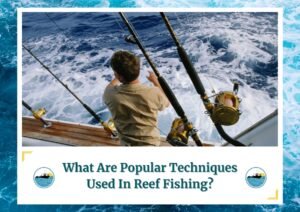
What Are Popular Techniques Used In Reef Fishing?
Reef fishing involves various fishing techniques depending on the environment and target species:
- Bottom Fishing: Use weighted rigs to target grouper and snapper near the ocean floor, keeping bait close to the bottom.
- Drift Fishing: Fish with the current or wind using baits or lures to cover a large area, perfect for catching snapper and grouper.
- Live Bait Fishing: Use live bait like sardines, shrimp, or small fish to attract larger predatory reef fish, often combined with bottom or drift fishing.
- Jigging: Move a weighted bait up and down to lure fish like amberjack and king mackerel, especially near reef structures and drop-offs.
- Spearfishing: Divers use spearguns to target reef fish in their natural habitats, requiring skill and precision, popular for hunting hogfish and parrotfish.
- Chumming: Toss small bits of bait into the water to attract fish like snapper and grouper to your location.
- Fly Fishing: Adapt fly fishing techniques with specialized flies and light tackle to target species like bonefish and permit in shallow reef areas.
- Trolling: Pull lures or baited hooks behind a slow-moving boat along reef edges to catch fast fish like barracuda and kingfish.
By using these methods, reef fishing becomes exciting and flexible. They let anglers explore the diverse and vibrant underwater world of coral reefs.
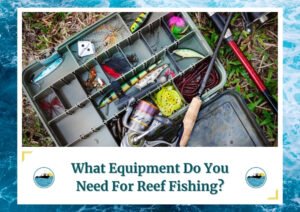
What Equipment Do You Need For Reef Fishing?
To fish in coral reefs, you’ll need gear that is specially made to handle the challenges of this type of fishing. Here are some essential items to have:
- Rod and Reel: When reef fishing, it’s best to use a medium to heavy spinning rod and reel combo. Look for a rod that handles 20-40 pounds and pair it with a high-capacity reel for catching a variety of species like snapper and grouper.
- Line: Use a braided line rated between 30-50 pounds for its strength and durability. Pair this with a heavy test line of 40-80 pounds of fluorocarbon leader, abrasion resistant to protect from coral and the teeth of reef fish.
- Terminal Tackle: Stock up on essential terminal tackle, including circle hooks, J-hooks, treble hooks, sinkers, and weights. These items are necessary for securing your bait and snaring a successful catch.
- Lures and Baits: Experiment with a mix of lures and baits to lure in various types of fish. Jigs, soft plastics, and poppers are great choices, as well as live bait such as shrimp, squid, and sardines.
- Tools and Accessories: Make sure you have pliers, a landing net, a gaff, and a tackle box in your fishing gear. A fish finder comes in handy for finding fish and navigating through reef formations. And, of course, don’t leave home without a valid fishing license!
- Safety Gear: Remember, safety comes first! Don’t forget to bring a first aid kit and a life jacket. Also, bring polarized sunglasses to reduce glare, sunscreen, and clothes to protect yourself from the sun.
- Optional Equipment: Don’t forget to bring fighting belts or harnesses to manage powerful fish. Some species put up quite a fight. Polarized sunglasses are great for seeing underwater, while a fish finder or GPS helps you find fish and navigate the reef.
With this gear, you’ll have a great time reef fishing. Successfully targeting the wide range of species that live in coral reefs.

What Kind Of Boat Is Best For Reef Fishing?
Want to find charter boats for reef fishing? Remember to think about the particular conditions and surroundings you’ll come across near coral reefs. The perfect boats for reef fishing are:
- Center Console Boats: Popular for their spacious and versatile design, these boats provide easy access to all sides of the open deck and handle various sea conditions with powerful engines for reef navigation.
- Bay Boats: Ideal for shallow water and reef fishing, their shallow draft allows them to approach reefs without causing damage and includes essential features for coastal and reef areas.
- Skiffs: Perfect for shallow reef areas, these small, flat-bottomed boats easily navigate tight spots and shallow waters, reaching areas larger boats can’t.
- Walkaround Boats: Combining cruiser comfort with sport fishing functionality, they offer storage cabins and shelter for extended reef fishing trips, with easy access to prime fishing spots around the reef.
- Catamarans: Known for their stability and smooth ride, twin hulls provide a stable platform even in choppy waters, with ample space for fishing gear and anglers, ideal for longer reef fishing trips.
- Flats Boats: Designed for shallow waters, their shallow draft allows easy navigation through complex reef structures, making them the ultimate choice for reef-rich areas.
These boats are tailored to provide an excellent reef fishing experience. They focus on stability, maneuverability, and reef access.

When Is The Optimal Time For Reef Fishing?
Success in reef fishing largely depends on factors such as tides, seasons, and weather conditions. Let’s explore these elements more:
- Tides: High tides draw fish closer to the reef, making them easier to catch, while low tides can be great for specific species. Knowing the tidal patterns is important for a successful trip.
- Seasons: Spring and summer are ideal for reef fishing due to warmer water and active fish like snapper, grouper, and barracuda. Fall is also good, bringing different species with cooler waters for a different fishing adventure.
- Weather Conditions: Ideal conditions include calm winds and stable weather. Cloudy days help by cooling the water and making fish less cautious, improving your chances. Always check the forecast to avoid storms and strong winds, which can make reef fishing risky and less enjoyable.
Considering these factors while planning your reef fishing trip will boost your chances of success. It will also make sure that you have a safe and fun time.

What Are The Benefits Of Reef Fishing?
There are many benefits to reef fishing, including:
- Adventure and Excitement: Targeting impressive reef fish like snapper, grouper, and barracuda adds excitement due to the challenge of catching these fish hiding in reef structures.
- Diverse Species: Reefs offer a variety of fish species like parrotfish, triggerfish, and amberjack, making each trip unique and exciting with different catches.
- Scenic Ocean Views: Enjoy stunning underwater views and a peaceful environment away from busy beaches, witnessing marine life in its natural habitat.
- Skill Development: Master techniques like bottom fishing, drift fishing, and live bait fishing, enhancing your angling skills at all levels.
- Physical Challenge: Navigate through conditions and battle energetic fish, providing a fun workout and improving physical strength.
- Social Aspect: Enjoy reef fishing with friends, family, or fellow enthusiasts, creating bonding experiences and unforgettable memories.
- Potential for Large Catches: Reefs are rich with marine life, offering prime spots for catching big fish and adding to the fulfillment of the fishing trip.
Enjoy a rich and adventurous experience through reef fishing. You’ll learn new skills and find yourself in nature. You will also make meaningful connections with others.
What is the Difference Between Offshore Fishing and Reef Fishing?
Offshore and reef fishing are distinct in terms of location, target species, and equipment required. Reef fishing occurs near coral reefs. It happens in shallow to moderately deep waters. It targets species like snapper, grouper, and parrotfish. Offshore fishing takes place in deeper waters far from shore. It’s to hook larger species like tuna, marlin, and sailfish. This kind of fishing needs larger boats and special gear.
What Types of Fish are Found Near Reefs in Florida?
The Florida reef fishing scene is home to many fish species. These include the tasty and plentiful Red Snapper and the mighty, large Grouper. Other exciting catches include Shark Snapper, Amberjack, Hogfish, and Barracuda. Each fish offers its own set of challenges and rewards. For more information on these and other reef-dwelling fish, check out our blog!
How to Book an Offshore Fishing Charter?
Excited for an offshore fishing charter boat adventure? Make sure you have a successful and thrilling experience with an experienced charter captain and all the gear needed. Get ready to reel in big game fish in deep waters. Reserve your spot for an unforgettable fishing experience with Fishing Daily Charters today!

